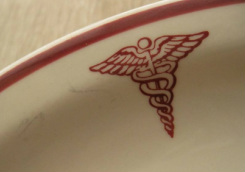 We have encountered this twice in recent weeks -- either a straight-up error, or the result of auto-correct undermining the writer's meaning: the acronym AIDS rendered as "Aids." One instance was in looking over a fundraising piece, the other when reviewing a medical information form from a dentist's office. All of the healthcare fields, and a few of the charitable/non-profit ones, need to be on the lookout for this specific error. Auto-correct saves us from a lot of mistakes...but opens up whole new possibilities for embarrassment. If there are acronyms that you use regularly in your line of work, make a Ctrl+F review of them part of your standard editing/revision process, in order to ensure that they are all properly capitalized. When abbreviating a multi-word name, the capitals are retained, partly as a clue that the resulting "word" stands for something else. "AIDS" represents the the term "Acquired Immune Deficiency Syndrome." Hence, must always be given in caps. Bonus: Both "HIV," the Human Immunodeficiency Virus (that causes AIDS) and "AIDS" are abbreviations. However, AIDS is also an acronym, as the abbreviation creates a name that is read as a word. The alternative would be to refer to AIDS by its individual letters, as the disease ay-eye-dee-ess. Whether or not an abbreviation is used as an acronym is not always obvious. The initial letters of the World Health Organization (WHO) creates a readable word, but the agency does not go by "the WHO (hoo)," as it could create confusion with the band of the same name. Ergo, even though it could be an acronym, it isn't used as such. So, CIA (Central Intelligence Agency), IRS (Internal Revenue Service), BBC (British Broadcasting Corporation) and IRA (Irish Republican Army) are abbreviations. NASA (National Aeronautics and Space Administration), NATO (North Atlantic Treaty Organization) and IRA (Individual Retirement Account) are abbreviations that are also acronyms. For vastly more on this topic, visit Wikipedia.
0 Comments
 We have encountered postal abbreviations for state names in narrative text quite frequently, of late. So, it seems time for a reminder that while there are a couple of legitimate options when referring in writing to one or more of the constituent parts of these United States of America, the USPS abbreviations are not among them. It's understandable how people can get into the habit of thinking of the state in which they live, and probably also the neighboring ones, to which they are prone to regularly address postal mail, in terms of the postal abbreviations. Though the addressing of mail using the postal abbreviations is ubiquitous, it is still a rare person who knows all fifty of them. When familiarity is not universal, use in text can leave a significant part of the audience wondering if AL refers to Alaska or Alabama. So, it is generally only correct to use a postal abbreviation as part of an actual address block (on an envelope, at the top of a letter, conveying a third-party's address in the body of a letter, anywhere when street/city/ZIP code are present, etc.) Our advice, for the sake of simplicity, is that within text or anything resembling traditional sentence structure, you should write out the name of the state. If you're just looking for a basic instruction, you can probably stop reading now and go about your day. ---------------------------------------------- ~ On the other hand, if you're interested in some of the qualifiers and digressions, continue: In the matter of postal abbreviations, different style manuals handle these things differently. The Chicago Manual of Style (CMOS) prescribes the advice that Write and Polish dispenses above. It is a clean and straightforward solution with nothing to look up or memorize. However, The Associated Press Stylebook (AP) has a set of abbreviations (and non-abbreviations) that it adopts for each state -- the so-called "traditional" abbreviations that pre-dated the postal system's two-letter designations. The majority of newspapers follow AP style, and these handles do clearly convey the necessary information. However, the traditional abbreviations follow no simple rule, like "three letters, first capitalized, ending with a period." They're each their own thing, including the eight that are never abbreviated! So, for the average person writing everyday business or personal material, to follow AP, you would need to refer to a list each time unless you'd learned them. Now, Write and Polish, being concerned about the aesthetic appearance of information on the printed (or rendered) page, writes the state name in its entirety in text AND IN ADDRESS BLOCKS. Though the postal system (their optical readers, actually) wants universal use of its two-letter codes, at present, our preference for what we find to be a more elegant look does not interfere with delivery. We will also admit, when dealing with our own materials, to a streak of obstinacy in the face of government-instituted homogenization! This W&P choice illustrates what is known as "house style." How material is presented can support, detract, or be neutral with reference to the brand and the organization's culture. A business or institution will often choose a major style manual to act as a "base" for its written material, and then supplement it with brand-specific requirements and other exceptions that constitute its own, hopefully distinct, style. House style should still be consistent with understanding, but allows for leeway in a variety of areas. For example, as of this writing, explicit direction to include or exclude the comma before the terminal conjunction in a simple series has become a "house" style point, as in: We color-coded our edits in red, blue, and green. or We color-coded our edits in red, blue and green. The first presentation was once de rigueur, but has largely gone by the wayside as unnecessary and redundant. For those who feel strongly about retaining that comma, however, spelling out the expectation in an internal style manual ensures that it is done consistently throughout the organization. Write and Polish is an avid follower of such Tweeters as @apstylebook, who recently reminded us to "use Dow Jones industrial average on first reference in stories. Use the Dow in subsequent references. #APStyle"
This directive is not just for the DJIA...it's an example of a first mention style differing from subsequent mentions. Initially, always give the most formal and complete reference to the person/company/institution that you will be discussing: His Holiness Pope Benedict XVI or Louisiana State University or the Department of Justice. Thereafter, you may refer to your subject in less detail, assuming that you audience remembers to what you are referring: the Pontiff or Pope Benedict, or Louisiana or LSU, or Justice or DOJ. If the entity is sufficiently well known by its abbreviation (FBI or MRI), you can safely use it in the initial mention without introduction. With most abbreviations, however, you will wish to inform your audience how you will be simplifying thereafter, like so: "The spokesman for Students Against Standardized Testing (SAST) stated.... Formed last May, SAST operates on the premise that...."  When making acronyms, initial-isms or abbreviations plural, no apostrophe is required -- IRAs, RFPs, CDs, FAQs, NSAIDs. Note that these are all multi-letter names that are treated as nouns in every way, including in their plural form. The exception is when discussing multiple occurrences of a single letter of the alphabet, like so: "Mary's handwriting has improved; her e's are now distinct from her i's." This exception is important when you consider that the apostrophe makes it clear that it is a letter of the alphabet under consideration, and not the word, "is." |
Write and Polish BloggersChristie Manussier, principal Writer and Polisher, is the usual news reporter. CategoriesAll Abbreviation Academic Acronym Adjective Adverb Anachronism Anagram Apostrophe Application Article Banished Biography Blend B.N.I. Boldface Brochure Bunnies Business Business Plan Capitalization Children's Literature Christmas Church Comma Common Mistakes Construction Contact Management Content Contest Cross-sell Databse Differentiators Donation Double Negative E-mail Entertainment Etymology Event Coordination File Format First Reference Flyer Fundraiser Giggles Gold Star Grammar Day Grant Proposal Haiku Health Care Homophones Hyphen Idiom Images Italics Law Firm Magazine Manual Marketing Maternity Leave Metaphor Myth News & Announcements Newsletter Non Profit Non-profit Noun Numbers Of Snakes And Presidents Parts Of Speech P.D.F. Plural Poetry Portmanteau Poster Powerpoint P.R. Preposition Press Release Projects Pronoun Proofreading & Editing Punctuation Quotation Marks Quotes Real Estate Recommended Reading Reflexive Research Resources Restaurant Retail R.F.P. R.I.P. Shakespeare Slideshow Social Media Spelling Style Manual Synonyms Syntax Template Tenses Testimonial Thesaurus Training Manual Translation Travel Twitter Underlining Verb Video Vocabulary Website Why The World Needs More Proofreaders Winter Word Of The Day Writers Writing Tip Archives
March 2015
|
Search by typing & pressing enter

 RSS Feed
RSS Feed